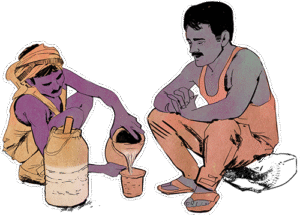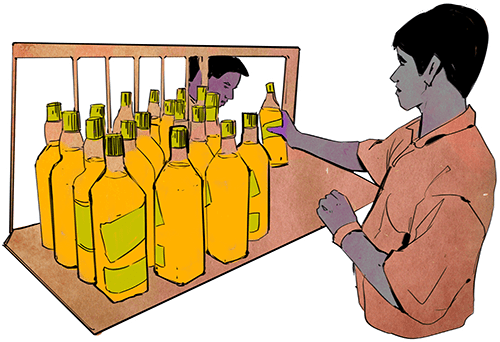
Prohibition: A Hangover of Failures
Hello beautiful people.
I hope you are all keeping well 🙂 Here is another edition of Mind of my Mind; a multi-part investigation into alcohol and it’s complicated relationship with the Individual, Culture and Society. Today we are diving into the subject of Prohibition.
It must be noted that though we have achieved the large hadron collider, philosophy, the moon landing, the green revolution and the Kardashians; on the topic of Prohibition we are still divided between those that claim that it works, and those that claim that it does not.
You see, at the start of the dream that was India, Mahatma Gandhi, along with many of his contemporaries, strongly opposed the consumption of alcohol, viewing it as ‘an evil that caused social and personal ruin. A substance that lead to violence, crime, and a loss of human dignity.’ He advocated for total prohibition, not just through voluntary effort, but through legislative and societal action. In his words in 1925, “…the one thing most deplorable next to untouchability in the drink curse.”
It seems his words were largely forgotten, because in 1987, a New York Times article quoted that in a 1985 survey conducted in four districts by the Indian Council of Medical Research reported that 20 percent of city drinkers had become alcoholics and that in some villages the proportion of alcoholics among drinkers was as high as 30 percent to 40 percent…
…Distillers in northern Uttar Pradesh paid 18 million rupees last year in excise levies to the local government…
…Yet despite the ban, production has increased, as many companies have taken advantage of growing middle-class prosperity and have worked their factories to the limit.
So clearly the dreams of a prohibited, or even a moderated society, was drowned.
But did we even try? Even for a second?
Yes, we did. And full marks for trying. But…Did it work?
Prohibition states
As discussed in the previous episode, our policy on alcohol is a strange cocktail of national and state legislation, with the state having total autonomy over such decisions. In this scenario some states have been more cognisant of the evils of alcohol, and have tried to enforce total prohibition based on their respective belief systems.

Gujarat embraced the Gandhian philosophy of being strictly against all intoxicants and banned alcohol in 1960 and has since remained a dry state. Nagaland on the other hand, banned alcohol based on it’s christian roots in 1990. In Naga culture, drinking is taboo and many Christian missionaries oppose drinking ferociously. And then there is Bihar (forever late to the party), that decided to ban the cursed venom in 2016 under the The Bihar Prohibition and Excise Act. Despite a massive blow to the excise collections, the ban was met with great aplomb, especially from women.
While these are examples of total prohibitions, there are states like Kerala, Mizoram and Manipur that have placed partial prohibitions. For example, Kerala with a partial ban, permits the sale of liquor in five-star hotels as well as the sale of wine and beer, stating that a complete ban would affect tourism, a vital source of income for Kerala.
These partial bans are a lot more messy and require a blog of their own at a later date.
The Twisted Ploy of Total Prohibition
Prohibition, though a sound philosophy, somehow reeks of inevitable failures. Though its efficacy is widely; and rightly debated, the reasons for total prohibition are understandable, and many — public health, domestic violence, financial ruin, decreased crime rates, etc. Prohibition also finds large scale support in women who are too frequently victims of domestic violence as a direct result of alcohol; one of the key factors for the prohibition of alcohol in Bihar.
But the story of prohibition is full of twists and turns. A fascinating study by Case Research Center, The Indian Liquor Industry Prohibition Story: The Politics of Liquor underscores a number of deeper issues related to prohibition.
For example, when The Haryana Vikas Party (HVP) promised prohibition, under the leadership of Bansi Lal in 1996. It cost the state 12 billion in excise revenue and led to a loss of 20,000 jobs in the alcohol industry. Additionally, 40,000 truckers, farmers and bottle producers were affected. A total of 98,699 cases were filed for intoxication or possession of liquor, over 13 lakh bottles were seized and 7,000 vehicles were impounded. To further add to the problems, taxes and fees for various for other state service were raised to balance the loss — power tariff (10-50%), bus fares (25%), and the petrol sales tax (3%).
This was meant to reduce the consumption of alcohol in the state. But the truth was that, illicit brewing and liquor smuggling became one of the biggest industries in Haryana overnight. Leading to an alarming increase in deaths resulting from the consumption of bad liquor. Soon enough, HVP lost 8 of the 10 Lok Sabha seats in the 1998 parliamentary elections and decided to lift prohibition in April 1998.
So, well, that failed. Miserably.

Similarly, in 1990, the women of Dubagunta, a small village in the Nellore district of Andhra Pradesh began an anti-arrack agitation. Using a plethora of tactics to pressurise men to stop drinking, they physically restrained habitual drinkers, attacked liquor shops and fought with the police and liquor mafia, prevented the entry of liquor into their villages, and stopped the district collectors from holding arrack shop license auctions. But in the agitation, women were beaten by liquor-henchmen, as well as, the police. Non-bailable cases were filed and there were even reports that many women activists were raped and murdered.
The conflict duly escalated into a massive national debate forcing the then Congress government to announce a statewide ban on the sale of arrack in October of 1993. Followed by N T Rama Rao (NTR) of Telugu Desam Party (TDP) implementing total prohibition on coming into power next. During this prohibition, the AP government lost 362 million in annual revenues and, like Haryana, had to raise taxes. The next CM Chandrababu Naidu lifted the ban in 1997, claiming the state’s financial problems.
It is important to consider is that post these experiments, multiple studies were conducted, the efficacy and validity of which are questionable at best. While the government-sponsored surveys claim that prohibition was successful, independent studies claim that it had, as mentioned before, failed. Miserably. To be clear, the independent surveys claimed that people were drinking openly and the police was simply ignoring them, while, the government quoted that 58% of the alcoholics had kicked the habit following prohibition and that liquor consumption in Haryana had come down by 67%.
Take your pick of the truth, please. No judgement.
Another experiment in 2015 was conducted in the district of Chandrapur, Maharashtra and was withdrawn in 2021. Based on the collector’s documentation, it appears to be a replica of the current happenings in Bihar (which we will get to next). The report, with damning evidence, declares the prohibition a ‘substantial’ failure. Noting that the sale of liquor had gone up, and large quantities of illicit liquor had started circulating through a thriving black market. The state government lost revenue despite the liquor trade increasing in the district, as revenue from liquor was driven into the black market and private hands. There was an adverse impact on the district’s social, health, and economic parameters in the five years of prohibition. There was a marked increase in the registration of criminal cases and arrests related to prohibition. And especially worrying was the growing involvement of women and children in the illicit liquor trade.
Another. Horrible. Failure.
Bihar Prohibition, the Thickest Plot of Them All
When in April 2016, Bihar implemented a blanket ban on alcohol. The policy was introduced as a means to restore social order, reduce domestic violence, improve public health, and minimise alcohol-induced crimes.
Cheers and applauds.
However, according to Policy Circle and ORF Bihar’s attempts at prohibition have also been a flying disaster! Not only has it failed to achieve its intended goals but has also led to numerous social and economic repercussions.
In October 2022, even the Patna High Court pronounced that the Bihar government had failed to implement prohibition. The state had witnessed multiple hooch tragedies by then, and had witnessed a rise in crimes including bootlegging by juveniles, villagers, politicians, and cops. The judge further observed that alcohol was freely available in the state, that minors were transporting liquor, and that drug consumption had increased post-liquor ban. Not surprisingly, he also found fewer cases registered against lynchpins of liquor cartels than the poor and marginalised.

One of the key rationale behind the ban in Bihar was its potential to curb domestic violence and alcohol-induced crimes. Though, once again unsurprisingly, the National Family Health Survey (NFHS) claims that the percentage of women who reported experiencing physical or sexual violence in Bihar increased from 39% in 2015-16 to 39.6% in 2019-20. The Bihar Economic Survey also notes that cases related to crimes against women have risen over the years.
This could be because while alcohol does incite violent behaviour, it is not the sole cause. It is important to keep in mind that domestic violence is a complex issue rooted in behavioural patterns, gender inequality, poverty, and a lack of a social support systems. Prohibition oversimplifies the issue by focusing exclusively on alcohol as the primary cause. Which might not be true in the first place and rather myopic on the part of policy makers.
And it would also be intellectually blind to not recognise that while alcohol consumption might have declined, though it hasn’t, there has been a steep rise in the use of alternative intoxicants such as toddy, ganja, charas, and mahua. A rise of 2,700% between 2015 and 2021 to be exact as per data.
Another justification for the ban was its supposed benefits for public health; arguing that alcohol consumption was responsible for numerous health problems, including liver disease, addiction, and accidents. But multiple studies indicate that outright prohibition has not reduced alcohol consumption; instead, it has driven the trade underground, making it unregulated and even more dangerous.
It would seem that prohibition is used as a political tool to consolidate the vote bank, especially that of ‘women’ voters. While the prohibition itself has failed, the politics of it has worked.
I also came across an almost surreal discussion, where the government proposed replacing liquor shops with milk parlours under the Bihar State Milk Co-operative Federation Ltd. While this approach might seem to be affective to some, it would definitely have been wiser to regulate alcohol sales, increase awareness of its risks, and invest in de-addiction programs rather than imposing an outright ban or half minded approaches for political gains.
But well. We all know how it really works.
Between you and me, it should be assumed that banning a product does not mean that people will not consume it; only that people will find another way to source it. Not to mention that consumers now pay significantly higher prices for illicit liquor, which is often of inferior quality. Over 39 lakh liters of liquor were seized in Bihar in 2023 alone, an average of 10,858 liters per day highlighting the extent of illicit trade.
The Debate and the Debacle
The experiences with prohibition all over the world prove that it fails. Every time. No arguments. Sociologists claim that it is impossible to make anyone stop drinking alcohol, especially by force. Unless a person is willing to quit, they would find means to obtain it. This is why illegal operators thrive during prohibition.
In India, Haryana gave up its attempts at prohibition due to its inability to control illicit distillation and bootlegging. Tamil Nadu and Kerala similarly failed at implementation. Even the Gujarat’s prohibition seems for the most part to be a charade, given its abundant supply of liquor from Daman, aided by administrative complicity. The truth is that Gujrati’s can access alcohol by various means and often struggle with alcoholism due to a lack of access to any help in a state that refuses to accept that it even has a problem.
To summarise what really happened then: The liquor ban was to curb domestic violence. But failed. And restore social order. But failed. And improve public health. But failed. And check and reduce crime. But failed. Instead it fuelled the growth of a black market, overburdened law enforcement, resulted in substantial revenue losses, and created a system that is blind to the real problems that come with addiction.
The hubris and the lack of empathy is painful to accept in this scenario. It would also be convenient to blame governments and governance for the lack of insight. But all that has already been done many times over, and has proven just as counter productive. Instead, I would ask, what do you think is a solution or even an insight?
Send in your suggestions at jha@monkeyverse.in.
—
Yuvraj Jha.
Concept Artist. Storyteller. Worldbuilder.
Join me wherever – @Instagram, @Threads, @Youtube
Shop for new arrivals by clicking the image below @Bandar Chhaap.
1 Comment
Comments are closed.


Pingback: Studio F-ARTs from September – Monkeyverse